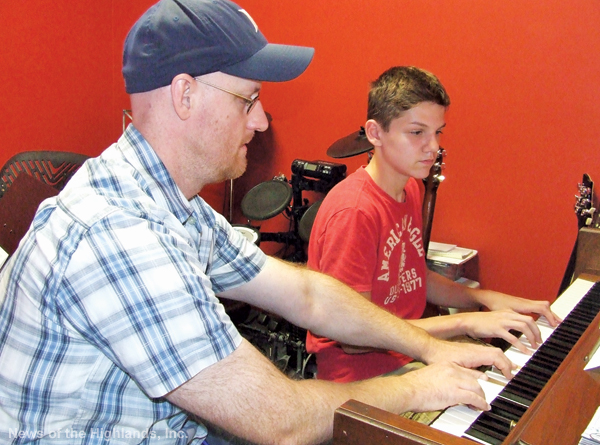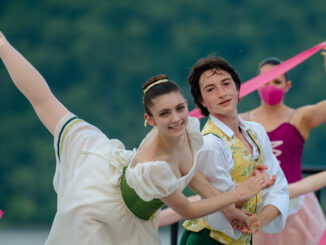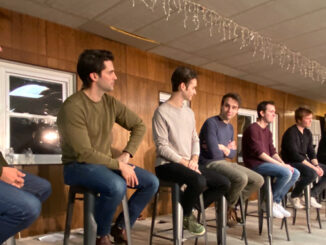Local schools’ arts programs down but not out!
By Jay LeRoy
This is part one of a planned two-part series about COVID-19’s effects on the performing arts in our area. In this feature, we’re taking a look at how local schools and student arts programs have responded to the challenges presented by the virus.
Next month’s second feature will focus on the pandemic’s effects on industry professionals in our area.
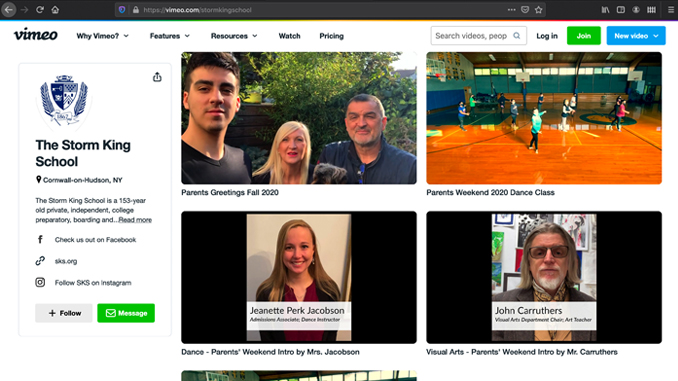
Storm King School
They memorized their lines, lyrics and mastered the choreography, they’d been rehearsing for months. Anticipation was high when two weeks before opening night – canceled.
Students at The Storm King School in Cornwall-on-Hudson were no strangers to disappointment last year. Not only did the pandemic throw a wrench into athletics but arts programs as well.
The cast and crew had been rehearsing since December of 2019 for their 2020 spring musical, “Chicago – High School Edition.” Shortly after that a dance recital was supposed to have taken place. Not to mention, the annual ARTS Weekend event that was lined up as well.
“That was disappointing, especially for the seniors,” said Anne Fulton, Performing Arts Chair at SKS, about the canceled musical.
But, as they say, the show must go on. Even if it has to be adapted for a different medium and slightly altered.
Megan Liggett, Visual Arts Teacher, remarked that the “ARTS Weekend” morphed into an “ARTS Month.”
“It became a collaboration between who was and wasn’t on campus at the time. It’s surreal how it all worked out, we were all anxiously hunched over our computers putting everything together.” Liggett went on to relate how she collected as much student artwork as possible, then drove to Odgen to have it all scanned so that it could be displayed online. John Carruthers, Visual Art Department Chair, helped create videos for the Spring Dance Show, Poetry Festival, musical recital and and even a performance of “Chicago.”
Every Friday beginning April 24, the school uploaded videos focusing on a particular arts event. Liggett noted it’s “nice that the kids can relive those moments since it’s all there online.”
But virtual performances just aren’t the same as live ones.
“Students were craving to perform and would video themselves. They wanted the chance to show off what they’d been working on. They really put their all into it,” said Jeanette Perk Jacobson, Dance Instructor.
“Their familiarity with TikTok helped,” quipped Fulton. “The kids were engaged – acting, dancing, making art – and all missed their opportunities to show it off as intended. And video isn’t the same. It was hard on them not being able to receive any audience feedback.”
Jacobson added, “I teach a junior who so badly wants to perform on stage before she graduates, even if it’s just for an extremely small audience.”
But the kids are alright.
In fact, it seems they’ve embraced the challenges.
“The students have been good about working with us through these difficult times. There’s a mentality of ‘we’re all in this together.’”
Megan Liggett, Visual Arts Teacher
“The students collaborated with us and took charge with their learning,” said Carruthers. He added that some elements of his virtual classes will continue when students are back in-person. Drawing apps such as Procreate and Sketchbook proved popular for online work and will now be used in-class. And Fulton explained that students are now using the Flipgrid video app to record themselves, noting it’s particularly good for seniors who want to present more polished performances videos to potential colleges.
And because there were no sports, the arts become something of a campus-wide phenomenon that everyone could rally around.
Online art exhibitions will continue, videos will still be recorded and this year’s spring show will go on (weather permitting, of course).
Fulton looks forward to the school’s outdoor production of “Godspell.” This will be the first time SKS has presented a musical outside. Although the cast will be smaller than usual – only 10 performers and a few crew members.
“There’s a particular energy, a particular excitement in the air,” noted Fulton. “We’ve never done this before and it’s exciting!”
Be sure to check the school’s website for further information about their upcoming production of “Godspell” at www.sks.org.
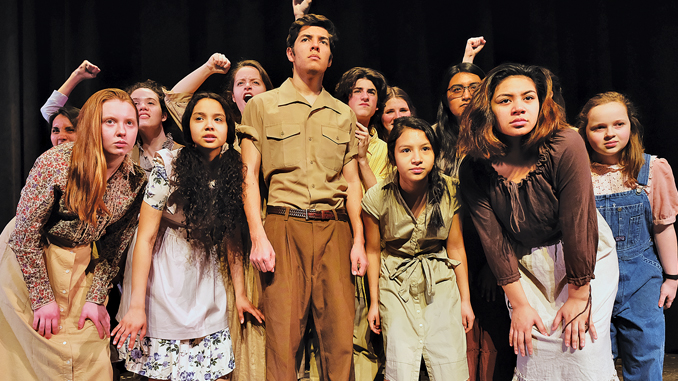
James I. O’Neill High School
If your show being canceled two weeks before opening night is disappointing, try getting the news less than a week beforehand!
“We were less than a week away from opening our production of ‘Urinetown’ when everything shut down,” said Natalie Arneson, O’Neill Drama Club director. “Originally, the school was going to close for two weeks. So I told the cast to keep practicing their lines and choreography and that we would be back soon. As the shutdown extended again and again, we held out hope that maybe we could do it towards the end of the school year, but of course it didn’t happen.”
But like for so many of us forced to stay inside and socially distance, Zoom proved to be a virtual godsend. The O’Neill Drama Club wasn’t about to miss out on their fall production and presented their rendition of the popular whodunit comedy “Clue” online.
Christopher Sheehan -Reynolds, Choral Instructor, related a similar set of challenges he and his students faced.
“There was a lot of confusion as to how and if schools could reopen, whether we would be remote, hybrid or fully in-person. Whether there might be multiple shutdowns if there were virus outbreaks, etc. New York State guidelines for band, choir and gym said that students had to be 12 feet apart in all directions.”
Which obviously meant, “Normal choral singing and rehearsals was not safe and not possible.”
So Reynolds took the opportunity to develop his students’ music reading skills throughout the fall.
“The hope was to elevate their skills as much as possible in hopes that some sort of normal rehearsals could resume,” he said. “In lieu of normal singing and rehearsals we are doing more of a music history course with some occasional related choral activities.”
And while the lack of practice has been discouraging, that didn’t stop the students and faculty from performing in one way or another.
Last semester, Reynolds arranged a virtual concert with his students. Each student recorded themselves for the piece of the music they were involved in. The videos were then painstakingly assembled together into a single cohesive production.
“It took a great deal of work but the final product turned out well and was, I think, a great thing for people to see and hear around the holidays,” Reynolds said.
Thomas Cunane, Music and Band Instructor, also found himself stymied by the pandemic.
“I was unable to complete any of my performance plans. Concerts did not happen,” he said. “In my electronic music class, as the students did not have the class software at home, they did not receive hands-on training from March to June. I had to teach lessons and then complete the assignments while the students looked on and interacted with me.”
This had forced Cunane to rethink his approach. And while not ideal, he’s been able to restructure his lessons to accommodate the majority of students who are learning remotely. He’s adapted his electronic music classes to utilize web-based software that students can use at home. While at the same time, he’s been doing his best with the hybrid students in attendance two days a week.
“Normal choral singing and rehearsals was not safe
Christopher Sheehan-Reynolds, Choral Instructor
and not possible.”
But everyone longs for the days of in-person learning.
“It is difficult for my performing ensemble, with a good portion of the students in full remote learning,” Cunane said. “This situation places a high level of responsibility on the students to learn their music with little assistance from me. I feel bad for my kids; I know they are frustrated. I really appreciate them hanging in there and doing the best that they can under the circumstances.”
Arneson’s cast is anxious to perform again as well.
“One of the great joys of performing is feeling the support of those who are enjoying you,” she said.
And while the O’Neill Drama Club had to scrap the tap show extravaganza they initially planned for, like The Storm King School they found a different approach to putting on a spring production.
“We are currently in online rehearsals for ‘Little Women,’” Arneson said. “If all goes to plan, we hope to produce an outdoor, socially distant concert version of the show that we can live stream if people are not able to attend.”
But as with all things dependent upon forces out of one’s control, Arneson says they’ve developed a Plan B.
“We are making plans to film the show in segments and piece it together in case we are unable to present it live.”
Though fingers are crossed it won’t come to that.
“We haven’t been together as a group in over a year. We are very much hoping that with strict safety protocols in place, we can present a live show later this spring.”
And as Reynolds succinctly put it, “I think our students deserve a lot of credit for being open minded and adaptable during these very trying times. I am proud of them and continue to hope that this pandemic forced diversion will prove to be a valuable thing in the long run.”
Follow O’Neill Drama Club on Instagram (@oneilldrama) for behind the scenes features.
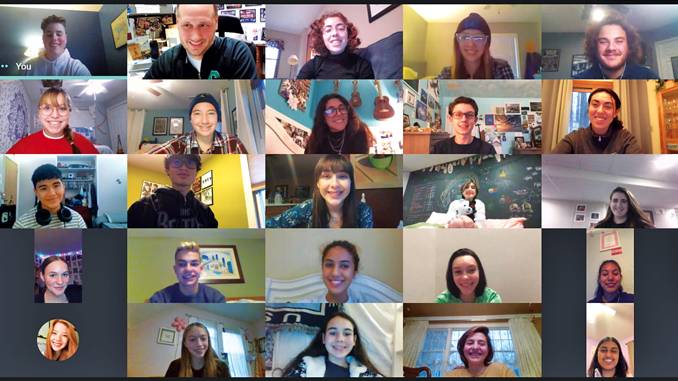
Cornwall High School
By Jason Kaplan
The performing arts provide a variety of benefits from helping to build self confidence and reduce anxiety to teaching empathy and compassion while improving listening and communication skills. When the pandemic forced schools to close a year ago, Cornwall High School students in the band, chorus, and drama club lost that outlet. When school re-opened in September with a hybrid program, the band and music teachers had to come up with new ways to teach their classes while still allowing students to express themselves.
In December 2019, an unknown virus started sweeping through China, but in the United States it was business as usual. The high school band had completed its winter concert and students were preparing to practice for the spring show upon their return from spring break. After nearly four months of rehearsals, the show was canceled. It was the first of many disappointments for the students.
“It [the pandemic] took away the closure seniors get with their final concert,” said Jake Hoover, the high school’s band teacher and director. “They always do a small speech at the end of the concert [talking about] what the music program has done for them during their time in Cornwall. The high school band also plays at graduation. They didn’t get that lead out into the next chapter of their life.”
Not only did schools and non-essential businesses shut down, but so did Broadway. Hoover said he plans two trips to see a musical during a student’s four years in high school. For some, that would have been their first time seeing a live performance on Broadway.
Despite students being back in school twice a week, the pandemic continues to prevent the district from putting on any concerts.
Due to all the restrictions and the limited time he gets to see his students, Hoover had to revise his curriculum focusing less on the performance aspect of playing an instrument and instead working on fundamentals such as what make music fun and developing a sense of community and belonging within the group.
Hoover went from seeing his students every other day to seeing them at best four times a month. Instead of practicing their instruments in the band room, which was converted into a cafeteria, students are spread out on the stage and in the seats of the auditorium. Of his 65 students, Hoover sees one cohort twice a week while the other half live streams into the class. The following week the roles are reversed.
“The quarantine has really drawn things out and made us look on a larger scale as opposed to what we’re doing week by week,” Hoover said. “What’s the overall goal? How do we keep the students engaged, interested, and happy? That’s what we wanted to focus on this year – giving the students a sense of reprieve, away from the computer. Letting them enjoy that time and keeping it fun and light.”
While the students still get a chance to play, they won’t be able to do so in front of an audience. Hoover said a number of difficulties come with trying to put on a virtual concert. The process requires expensive computer programs and a college education to learn audio and visual recording. Another variable that makes putting on a virtual concert difficult is the quality of the audio and video students have access to at home. While it’s easy to teach students to play at the same tempo while in person, it’s exceedingly difficult to get them to play at the same speed through video, said Hoover.
“The quarantine has really drawn things out and made us look on a larger scale as opposed to what we’re doing week by week.”
Jake Hoover, CCHS band teacher & director
For 18-year veteran Anthony Ravinsky, the high school’s choral and drama club director, this past year has had him feeling like a first-year teacher pivoting instruction to come up with creative ways of keeping music in the kids’ life during the pandemic.
“I asked my students, ‘Why are the arts important and how did it help you get through the pandemic?’ A lot of them leaned on music to relax them, keep them focused, and give them motivation to keep going. Music has definitely been important during the pandemic.”
Ravinsky has about 250 chorus students, but teaching sessions have been more disjointed this year than in the past. In a normal year, students are broken up by period and Ravinsky sees between 30 and 60 kids during a rehearsal. He typically doesn’t see the full chorus until the group starts meeting evenings before a concert. During the pandemic, he sees about half as many students. They rehearse on stage or in the cafeteria to maintain a 12-foot distance. The students also wear masks, making it difficult to hear them.
“It’s a lot of small groups and repeating, but it’s worth it to give them the experience,” said Ravinsky.
The chorus hasn’t performed since the fall of 2019, so Ravinsky has had to draw his students’ attention away from the performances and pivot elsewhere. Instead, he’s focusing on more skill based needs and technique. When the spring show was canceled last year, the students had already been rehearsing for about two months. Although the final performance is the icing on the cake, Ravinsky is focusing instead on the skills learned during the process such as the collaboration and the perseverance. Rather than a group performance, students are required to submit individual recordings.
“For me to assess my students, they have been recording assignments at home. Most people hate hearing themselves sing. These kids have had to rise above some of their apprehensions and some of their fears. That is what the arts are about. That’s what performing is about.”
Unlike the band and chorus, the students in the Drama Club have had a little more success seeing their hard work pay off with some sort of performance. In December, students were able to perform “It’s a Wonderful Life.” Rather than act out their parts on stage, the performance took on the likes of a simulated radio broadcast. Performers played several parts and the show included radio-styled sound effects, as well as jingles and commercials. The show was streamed three times over the course of three days.
This May, about 30 students, split into two cohorts, will be taking the stage outdoors, rather than inside the auditorium. Ravinsky said performing outdoors isn’t easy, as sound reinforcement is one of the biggest issues.
“For the few kids who were able to fit this into their schedules, I’m happy we’re able to have some of the kids back,” he said. “It’s definitely not the full drama family, but with all the restrictions we had to trim back a little bit.”
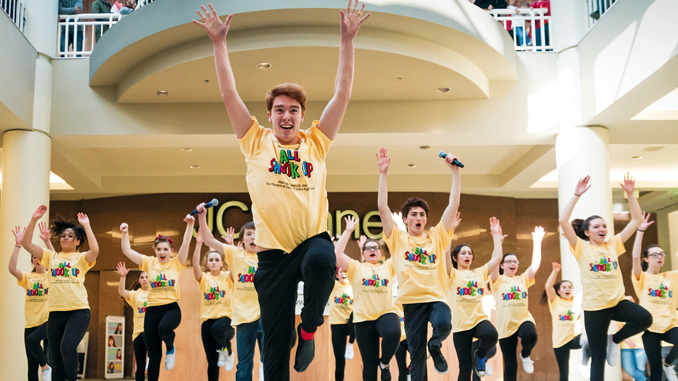
Orange County Arts Council (OCAC)
By Jay LeRoy
JC Penney Square inside the Galleria at Crystal Run, Middletown, will be noticeably quiet this year.
You won’t be watching Orange County students perform songs from upcoming spring productions during OCAC’s High School Musical Preview. Nor will you find student artwork on display for the People’s Choice Art Exhibition.
It’s a blow to the momentum the event had been building over the years.
“Last February, just before lockdown, we had our most popular and well-attended showcase,” said Gretchen Weerheim, Director of Communications for OCAC.
Officially titled “The ARTS Build Confidence – Student Arts Showcase,” the program started in 2014. Former OCAC Executive Director, Dawn Ansburough, invited Orange County educators and artists to form an Education Committee. Together they would brainstorm ideas to better endorse and support the arts among the county’s schools.
One way to do that, they decided, was with the People’s Choice Art Exhibition at the Galleria at Crystal Run. Featuring artwork from students in grades 9 through 12, viewers could vote on their favorite pieces with three lucky winners receiving ribbons and prizes of coveted art supplies.
“About half of Orange County schools initially participated. But it became incredibly popular once people had a chance to see all of the amazing student artwork,” Weerheim said. “It’s since grown to include more school districts, including private schools and BOCES.”
Even students in grades K through 8 had the opportunity to show off their creativity. Screens were set up around JC Penney Square with slides of artwork projected large for all to see.
“Kids get a boost of confidence seeing their artwork
Gretchen Weerheim, OCAC Director of Communications
on display.”
However, Education Committee member Michael Pacer, a former Port Jervis music teacher, wanted to incorporate a student musical preview into the increasingly popular event.
And so the High School Musical Preview became a yearly staple. This gave schools a chance to perform numbers from their upcoming productions.
Unfortunately, due to the pandemic, last year’s musical preview was the only chance the majority of schools had to showcase highlights from their eventually canceled shows.
But Weerheim says COVID-19 couldn’t stop the Education Committee from going forward with the The ARTS Build Confidence – Student Arts Showcase. In fact, Pacer proclaimed, “I want to think out of the box, do something big!”
Which meant adapting the arts showcase to the pandemic era.
Unfortunately, there are no plans for the High School Musical Preview this year. But the student art exhibition has found a new home in an unconventional venue.
Drive-in movie theaters have seen a resurgence in popularity during the pandemic. So it’s only fitting that Warwick Drive-In will play host to this year’s art showcase. Tentatively planned to run for several weeks from May through June, 15 pieces of artwork per school district will be displayed before the first and second films each night.
Due to limitations presented by this new format, there will be no voting for popular works this year. But attendees will receive a card with a special QR code they can scan to find out more information about the artwork seen on screen.
More information about this special event will be available on the Orange County Arts Council’s website at www.ocartscouncil.org.

